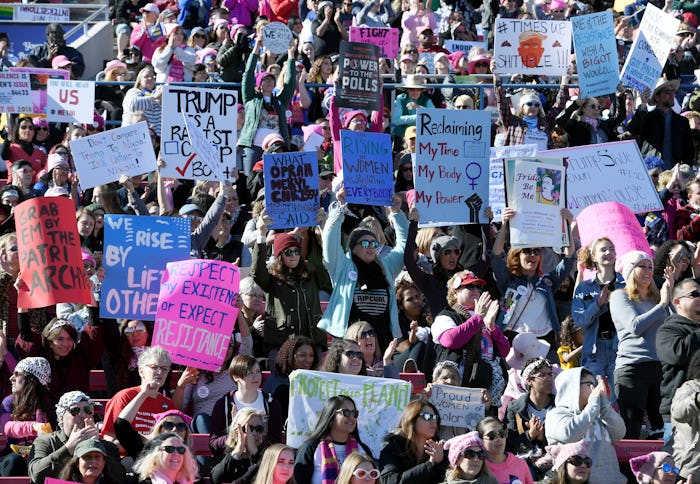News

Here's What You Need To Know About The #WomensWave
On Jan. 19, 2019 millions of women are planning to take to the streets once again to protest a host of -isms — racism, sexism, classism — and support better standards for the treatment of women. You may have seen the term #WomensWave on social media in discussions about the event, but what is the #WomensWave exactly, and what does it mean for the march?
The #WomensWave is the theme that the global march organizers chose for this year’s march, according to the event’s website. It was specifically chosen to address the issue of domestic violence, the organizers said, “The organisation, in alliance with its worldwide Chapters, has set the event’s theme to END VIOLENCE AGAINST WOMEN.” The march reported that 1 in 3 women have experienced physical or sexual violence, and their mission is to “enable women to have a voice, and ultimately contribute to their peace and safety.” So the march is really about much more than just walking and holding a sign; it’s about advocacy for an important issue. The event’s site noted that they are building efforts according to a plan called “H.E.R.S.” which “advocates for the health, economic security, representation and safety of women worldwide.”
Some people might also consider the recent election to be part of the #WomensWave.
Women got out to the polls and elected a record number of 110 women to the House of Representatives, according to Forbes. The paper reported in since the 2016 election, organizations have sprung up and galvanized waves of women to get involved in running for office and/or supporting candidates. The results gave the United States our first Native American women in Congress, our first Muslim women in Congress, and many other firsts, like South Dakota’s first female governor, according to TIME.
Women were partially energized to get out and vote by the then-recent confirmation of Brett Kavanaugh to the Supreme Court, The Guardian reported. One woman told the paper, “You can’t stay at home when something like this is going on. Women are feeling empowered and stronger and it’s no longer going to be the good ol’ white boys’ club. It can’t be anymore.”
In fact it was Kavanaugh’s confirmation that moved the organizers of the previous women’s marches to make 2019’s march official. “Out email inboxes were full ‘Women’s March, where are you? When are we marching? Tell us when? Tell us where.’” a chairwoman for the march told the New York Times.
But it’s not just American women who want to march, women all over the world have been spurred to organize marches in their cities. Johannesburg, Pakistan, and Indonesia are just a few of the countries where marches will occur, as well as all over Europe, according to the march’s website. In fact, every continent except Antarctica will host marches, though members of an expedition to the frozen continent also marched in solidarity in 2017, USA Today reported.
2019’s official march date is Jan. 19 and with hundreds of marches across the U.S. there is probably one near you. To find out where marches are happening and get more information visit the event’s global website. Then find some comfortable shoes, make a sign, and join in the wave.